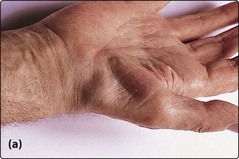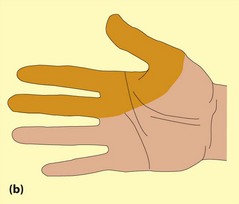Common peripheral nerve lesions
Peripheral nerves can be affected in isolation, so-called mononeuropathies. However, only a few peripheral nerves are involved frequently. The commonly involved nerves are usually affected by entrapment at sites of vulnerability. This can be exacerbated by conditions that render the nerves more susceptible, for example diabetes and hereditary liability to pressure palsies. Isolated mononeuropathies can rarely be the onset of mononeuritis multiplex (see above).
The types of nerve injury are given in Table 1. Injuries are usually a combination of neuropraxias with some axonotmesis.
| Type of nerve injury | Structural changes | Rate of recovery |
|---|---|---|
| Neuropraxia | Myelin damage, axon intact | 2–12 weeks |
| Axonotmesis | Loss of axonal continuity, epineurium intact | Regeneration at 1 mm/day from site of lesion |
| Neurotmesis | Entire nerve trunk separated | No regeneration unless nerve repaired; then 1 mm/day |
Median nerve
It commonly presents between 40 and 60 years of age, more often in women. The dominant hand is usually affected first. Initially patients are awoken with tingling and pain in the hand, which they characteristically shake on waking ‘like a wet fish’. Later they notice tingling or numbness during the day. They may start dropping things and note some weakness of grip. If severely affected, they may notice wasting of the abductor pollicis brevis (APB; Fig. 1a).


Fig. 1 Median nerve. (a) Wasting of abductor pollicis brevis; (b) sensory loss of median nerve lesions.
On examination, there may be wasting or weakness of the APB. Sensory changes of varying degrees are found within the median nerve distribution (Fig. 1b). Additional tests include Tinel’s test (percussion of the nerve to provoke paraesthesiae in the median nerve distribution) and Phalen’s test (dorsiflexing the wrist for 30–60 s). However, there are significant doubts about the sensitivity and specificity of these tests.
Stay updated, free articles. Join our Telegram channel

Full access? Get Clinical Tree


